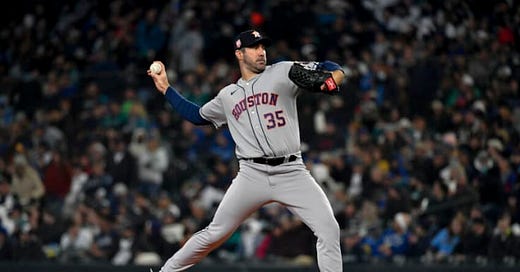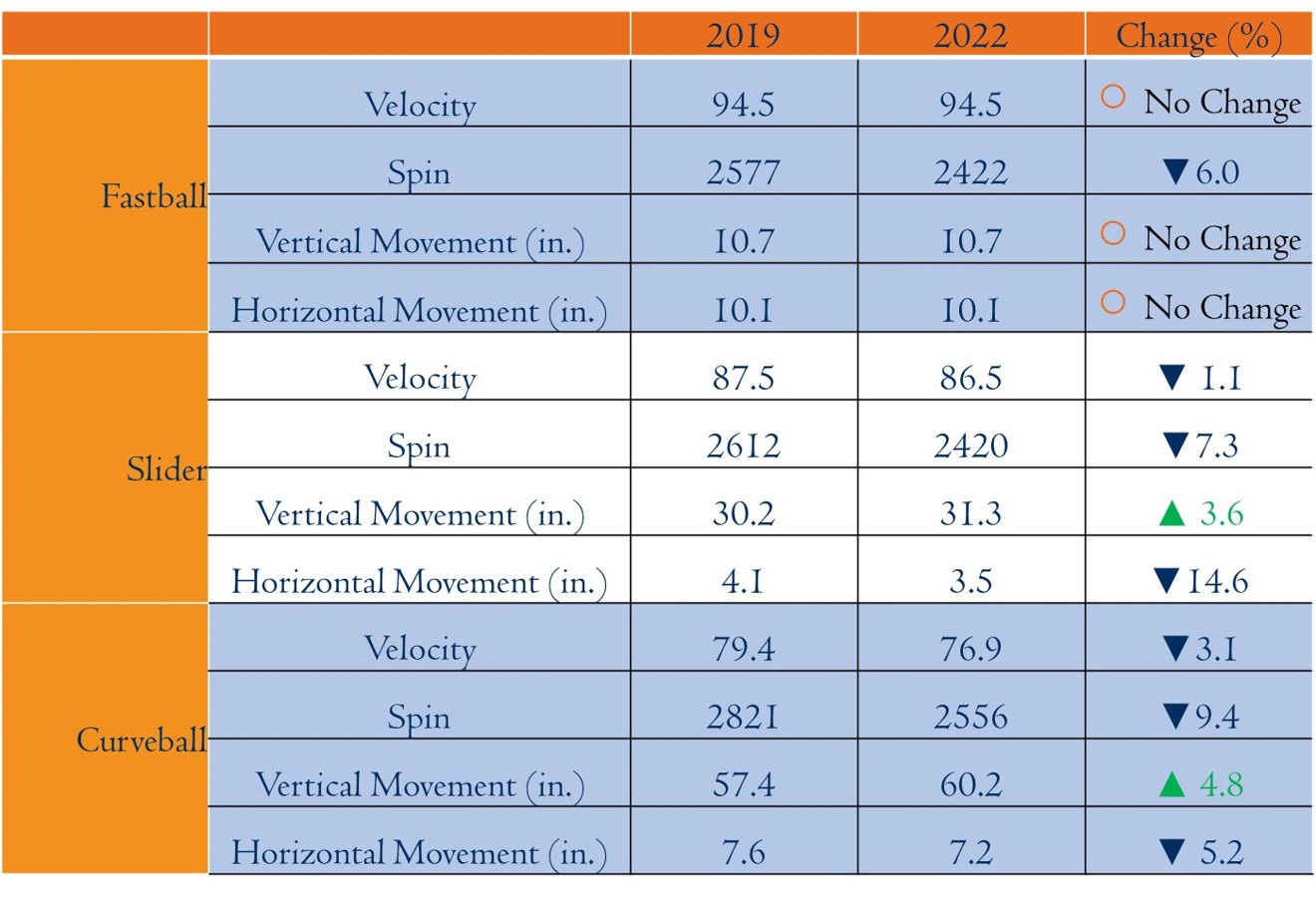Is Verlander Back?
He's Throwing His Fastball Like He Did in 2019, but His Breaking Pitches Aren't Quite As Sharp...So Far
There was only one bright spot from the Astros weekend trip to Seattle, but it was a strong one.
On Saturday night, Justin Verlander turned in the best start of the season by an Astros pitcher, and possibly by any major league pitcher. Verlander shut out the Mariners over 8 innings, allowing only 3 singles and no walks, while striking out 8.
In his postgame press conference, Dusty Baker commented on Verlander’s performance saying “That’s what aces do. They stop losing streaks. And he’s one of the best at it.”
Verlander’s performance on Saturday night was also notable because it was his second start back from an elbow injury that required Tommy John surgery in October 2020 and compelled Verlander to miss the entire 2021 season.
Observers hearkened back to Verlander’s past in describing his performance Saturday night. Both the Houston Chronicle and Seattle Times used the term “Vintage Verlander” in headlines to their game stories, while Matt Snyder of CBSSports.com described him as “Prime Verlander.”
And if we are seeing “Prime” or “Vintage” Verlander, then can we say that he is back.
It is hard to answer this question after only 2 games post Tommy John. Small samples make is hard to do analysis and draw firm conclusions. The Mariners could have been hitting in back luck, or Verlander just had some good fortune. or both.
In short, results can vary, especially in short samples. So instead of results, I’m going to look at the process. That is, I’m going to look at how Justin Verlander goes about throwing a baseball. Data provided by Statcast that about how a baseball is thrown should normalize more quickly than data that involves the role of batters and fielders. And that provides an avenue to determine how similar or different Verlander is throwing this year in comparison to 2019.
The chart below looks at four measures of three different types of pitches1 that Verlander throws—velocity, spin, vertical movement, and horizontal movement. I included a column for the Statcast measurement for each category, and included a column titled “Change,” which shows how much the measure has changed since 2019.
Verlander’s fastball looks basically the same as it did in 2019. He is throwing it at an average of 94.5 MPH, and it has the exact same amount of vertical and horizontal movement as it did in 2019. Verlander’s fastball drops less than that of an average major league pitcher, in large part because Verlander is very willing to throw it at the top of the zone, risking hard contact, to contrast with his off-speed pitches which target the bottom of the strike zone. One reason that Verlander can get away with his high fastball is that he has a lot of natural horizontal movement on his fastball at 10.1 inches. This makes it hard for batters to square up, or even make contact with the fastball.
Verlander’s breaking pitches are not quite up to the quality that we saw in his Cy Young season of 2019. He is throwing his slider one mile per hour slower, and its horizontal movement is less this season. He is getting more vertical movement on the pitch.
There is a similar story on Verlander’s curveball. He is not throwing it as hard this season, and it is generating less horizontal movement. But he is getting more vertical movement on the pitch. That is, both the slider and the curveball for Verlander are dropping more than in 2019, even if they are not breaking as much.
One measure is down across the board for Verlander—his spin rate. Verlander is spinning his fastball 6.0% less than in 2019, his slider 7.3% less, and his curveball 9.4% less. Of course, Verlander is not alone in having his spin rate go down. After the mid-season 2021 crackdown on sticky stuff, spin rates went down across the league. So Verlander’s spin rates are down, but it is harder to know what to make of that difference based on the different set of rules enforcement between the two seasons.
Overall, the chart here shows that Verlander is pretty close to being “back” to his 2019 set of pitches. His fastball looks essentially the same as it did back then. His breaking pitches are close. His changeup is his least used pitch—Verlander threw it only on 4.2% of his pitches in 2019—and Verlander either does not feel confident with it yet, or prefers his other, more effective pitches.
Of course, not all pitching is about the four measures discussed here. These tell us nothing about control or command. Verlander was better at that in his second start in Seattle (0 walks; 74% strike percentage) than in his first start in Anaheim (3 walks; 58% strike percentage). Verlander’s command is another key to his recovery from Tommy John surgery.
But on Saturday night in Seattle, Verlander certainly looked like his old self. He’s not quite as sharp with his pitches as he was three seasons ago. But he was sharp enough to get a big win for our boys. We have great reason to hope that will continue.
Verlander actually throws 4 pitches. But he has thrown only one changeup so far this season. This is obviously not enough data to analyze, so I do not include Verlander’s changeup from either season.





